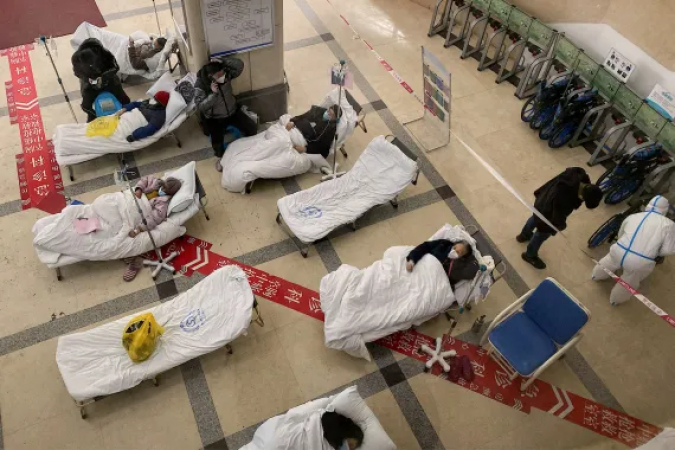
BEIJING: Yao Ruyan was running at a frantic pace in front of the fever clinic of a county hospital in China's industrial Hebei province, 70 kilometers (43 miles) south of Beijing. All the nearby hospitals were full, and her mother-in-law had COVID-19 and needed immediate medical attention.
She shouted into her phone, "They say there are no beds here."
Emergency wards in small towns and cities southwest of Beijing are overburdened as China struggles with its first nationwide COVID-19 wave.
A shortage of beds has patients lying on benches and on the floor in hospital corridors, and intensive care units are turning away ambulances and scrambling to find available beds for relatives of the sick.
Also Read: Bethlehem recovers from the pandemic, cheering up Christmas time
Yao's elderly mother-in-law was taken ill by the coronavirus a week ago. He first went to a neighborhood hospital, where a lung scan revealed pneumonia.
Yao was informed that the hospital is unable to manage severe COVID-19 cases. He was instructed to visit major hospitals in neighboring countries.
All the wards were full as Yao and her husband traveled between hospitals in their car. Zhuozhou Hospital, an hour's drive from Yao's hometown, was the most recent lethargy.
Yao passed the wheelchairs that elderly patients were hastily pushing toward the check-in desk. She was informed that the hospital was already at capacity and would have to wait.
"I'm angry," Yao said, breaking into tears as she underwent a lung scan at a neighboring hospital. I'm not very hopeful. We've been out for a while, and now that he's having trouble breathing, I'm scared.
Associated Press reporters spent two days visiting hospitals and cremation grounds in towns and villages in the central Hebei province prefectures of Baoding and Langfang.
The region served as the epicenter of one of China's first outbreaks, after the state relaxed COVID-19 controls in November and December. The area was silent for weeks as people stayed home due to illness.
Now many people have recovered. Even as the virus spreads to other regions of China, markets are humming, diners fill restaurants, and cars honk in gridlocked traffic. Recently, state media reported that the region was "resuming normal life."
However, the situation in central Hebei's emergency rooms and cremation grounds is anything but normal. Many of Hebei's elderly are deteriorating rapidly, despite the fact that young people are returning to work and waiting times at fever clinics are shortening.
They are taking over funeral homes and intensive care units, which may be a sign of things to come for the rest of China.
Since restrictions were heavily eased on December 7, the Chinese government has reported only seven COVID-19 deaths, bringing the country's total death toll to 5,241.
A Chinese health official claimed on Tuesday that China's official COVID-19 death toll only included cases of pneumonia or respiratory failure, a strict definition that leaves out many cases that other countries have attributed to COVID-19. Will settle
Between one million and two million people are expected to die in China by the end of the year, according to experts, and a top World Health Organization official warned that Beijing's counting method "will underestimate the true death toll". "
Also Read: Kurds and anti-racism organisations gather following the deadly Paris shooting
The emergency ward hallway at Baoding No. 2 Hospital in Zhuzhou was packed with patients on Wednesday. Respirators were being used to assist the sick in breathing. When doctors informed a woman that a loved one had passed away, she sobbed.
The ambulance had to be turned away from the ICU due to overcrowding. A medical professional yelled at family members who were escorting a patient from an arriving ambulance.
The employee said, "There is no oxygen or electricity in this corridor. How can you save him if you can't even give him oxygen?"
If you don't want any delay, you should quickly turn around and leave. she said.
As the family members left, the patient was wheeled back into the ambulance. With flashing lights, it flew away.
AP reporters toured the area for two days and saw about thirty ambulances. Two ambulances were following each other on a highway leading to Beijing, their lights flashing, when a third ambulance passed the other way.
Beijing city officials earlier this month reported a sixfold increase in emergency calls, leaving dispatchers overburdened.
Some ambulances are making their way to cemeteries. The furnaces at the Zhuozhou crematorium are reportedly burning out of time as staff members struggle to deal with a rise in the death toll over the past week.
According to a funeral home employee, the number of bodies cremated daily has increased from three to four before the loosening of COVID-19 restrictions.
A worker at a funeral supply store close to a community hospital, Zhao Yongsheng, declared, "There have been so many deaths. Even though they try, they can't burn them all.
According to the 82-year-old woman's grandson Liang, the body of one 82-year-old woman was transported from Beijing, a two-hour drive away, to a crematorium in Gaobeidian, about 20 kilometres (12 miles) south of Zhuozhou.
Due to the sensitivity of the situation, Liang only revealed his last name when he said, "They said we'd have to wait for 10 days."
When she developed coronavirus symptoms, Liang's grandmother had not received a vaccination, and she had spent her final days in a Beijing ICU hooked up to a respirator.
Also Read: Old divisions tearing at Brazil days before new president
On Thursday, AP journalists spent more than two hours at the Gaobeidian crematorium watching three ambulances and two vans unload bodies.
About 100 people huddled together in small groups, some wearing traditional white Chinese mourning clothing. Both fireworks and funeral paper were burned